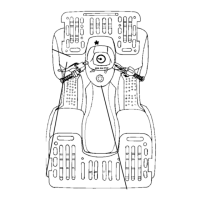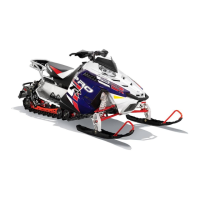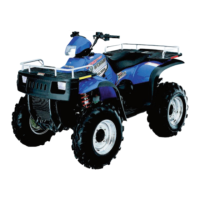What to do if my Polaris 600 Fusion has poor quality fuel?
- JJennifer GomezJul 27, 2025
If your Polaris Offroad Vehicle has poor quality fuel, replace it with higher quality fuel.
What to do if my Polaris 600 Fusion has poor quality fuel?
If your Polaris Offroad Vehicle has poor quality fuel, replace it with higher quality fuel.
How to fix incorrect jetting on my Polaris 600 Fusion Offroad Vehicle?
To fix incorrect jetting on your Polaris Offroad Vehicle, use the correct jetting for your altitude.
| Brand | Polaris |
|---|---|
| Model | 600 Fusion |
| Category | Offroad Vehicle |
| Language | English |
Record your snowmobile's identification numbers and key number in the spaces provided.
Store the manual for convenient reference and follow the recommended maintenance program for safe operation.
Details Polaris' commitment to environmental education and responsible snowmobile operation.
Explains signal words, symbols, and general safety precautions for operating the snowmobile.
Warning about entanglement hazards with the snowmobile's track and moving parts.
Guides on maintaining proper body position for control and safety while riding.
Recommends appropriate warm and protective clothing for riding, including helmet and eye protection.
Advises on carrying essential survival equipment when riding in remote or challenging conditions.
Warns against excessive speed, especially at night or in poor visibility, and its consequences.
Emphasizes being alert to obstacles, road crossings, and varying terrain conditions.
Provides safety guidelines for snowmobilers in mountainous terrain regarding avalanche awareness.
Details issues related to ice and snow build-up affecting steering and other systems.
Advises on caution and reduced speed when operating on icy or hard-packed snow surfaces.
Provides guidance on safe weight shifting and braking techniques for downhill riding.
Offers advice on body positioning and maneuvers for safe operation in hilly or sloped terrain.
Covers courteous riding, safe group riding practices, and securing the vehicle when unattended.
Identifies the location and meaning of various warning decals on the snowmobile.
Identifies key external components of the snowmobile through diagrams and labels.
Identifies various controls and instruments on the snowmobile's console and handlebars.
Explains how to adjust the steering system for different riding styles and preferences.
Explains the function of the DET system in preventing engine damage from detonation.
Covers the identification of MFD components and digital display elements.
Identifies the various analog and digital gauges and indicators on the MFD.
Explains how to configure MFD display preferences, units, and speedometer/tachometer views.
Details how to navigate and utilize different display programs like Performance, Engine, and History.
Guides on adjusting the Independent Front Suspension (IFS) for optimal ride and handling.
Covers how rider weight, style, and conditions affect rear suspension action and adjustments.
Details the adjustment procedures for the IQ rear suspension, including sag measurement.
Guides on tuning the FAST M-10 rear suspension for rider weight and ride quality.
Covers adjusting handlebar position and angle for rider preference.
Discusses traction products like studs and carbides for improved control on various surfaces.
A comprehensive checklist of items to inspect before operating the snowmobile.
Outlines critical checks for the throttle, brakes, steering, and other systems before starting the engine.
Covers checks for engine stop switch, ignition, tether switch, lighting, and mirrors after starting.
Provides step-by-step instructions for starting cold and warm engines, including choke usage.
Explains the critical procedures for breaking in a new or rebuilt engine to ensure longevity.
Covers safe handling of gasoline, refueling procedures, and exhaust fume hazards.
Explains the low oil indicator light and the importance of maintaining proper oil levels.
Discusses the critical role of carburetor adjustment and mixture for engine health.
Explains the operation of the engine stop switch for quick shutdown.
Details the function and testing of the throttle safety switch for automatic engine shutdown.
Lists various methods for stopping the snowmobile in emergency situations.
Details how to engage and disengage the electronic reverse system safely.
Outlines the recommended maintenance schedule and the owner's responsibility for upkeep.
Provides a detailed table of maintenance items and their required intervals based on mileage.
Details lubrication points and procedures for front, rear, and specific components.
Covers routine maintenance tasks such as spark plugs, filters, and fluid checks.
Advises on spark plug selection, gap, torque, and replacement intervals.
Covers inspection of hydraulic brake components, including pads and lever travel.
Covers inspection, cleaning, and adjustment of clutch components for optimal performance.
Advises on checking the drive belt for wear and carrying a spare.
Covers track inspection, lubrication, and tension for safe and optimal performance.
Covers inspection and adjustment of steering system components.
Details cleaning and preservation steps for the snowmobile before extended storage.
Emphasizes engine and fuel system preparation, including fogging and fuel stabilization.
Provides instructions for safely transporting the snowmobile.
Provides a guide to diagnose and resolve engine-related problems.
Offers solutions for common problems encountered with the IQ suspension system.
Provides solutions for common problems encountered with the M-10 suspension system.
Guides on diagnosing and resolving issues related to drive belt wear and burn.
Explains how to obtain service and warranty assistance from a Polaris dealer.
Outlines the terms and conditions of the limited warranty provided by Polaris.
Lists conditions and exclusions that may affect warranty coverage.
Details the terms and coverage of the free Second Year Engine Service Contract.
Outlines procedures for obtaining service both within and outside the country of purchase.











